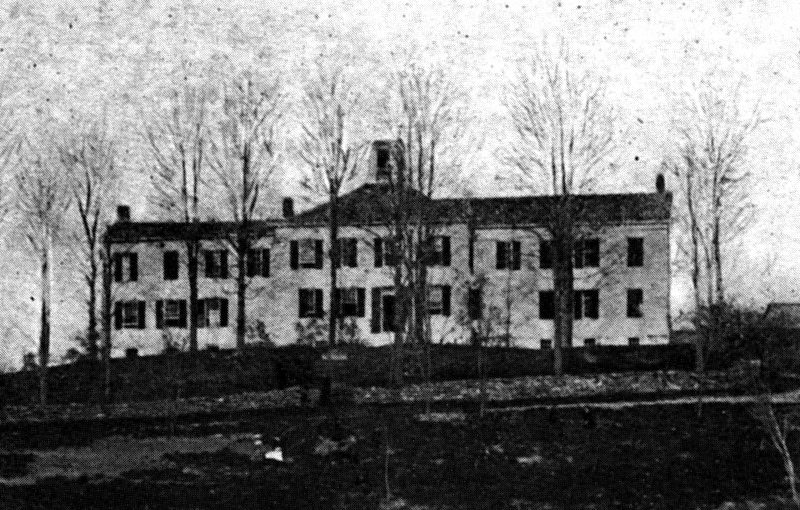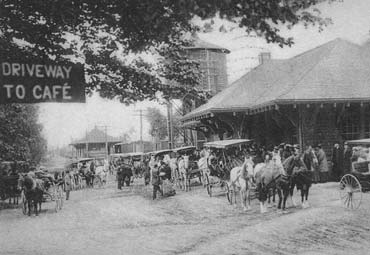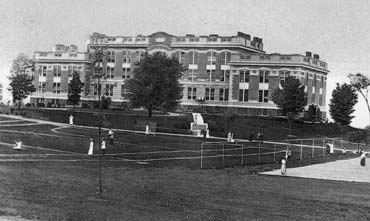
New Paltz Normal School, 1860
The New Paltz Normal School
Winter 2007
April 18, 1906
Many people remember and many more will remember, if only briefly, the San Francisco earthquake of 1906. It occurred at 5:13 in the morning on April 18th, an 8.25 on the Richter scale, on an otherwise clear day. It was a catastrophic event that brought down buildings and killed people. The earthquake lasted 48 seconds and its psychological aftershocks continue today. The nineteenth century was a battleground where scientists and deists argued the primacy of science or God. It was a battle that science was winning. Religion, a thousand years before, provided an explanation for the inexplicable but in the ensuing centuries saw its role as judge of natural events subsumed to increasingly scientific explanation.
For those who would like to consider what can be described as freak bad luck, cosmic chance, or divine intervention another event occurred the day of the earthquake 2,548.11 miles away, a serious fire in New Paltz, New York, a town located midway between New York City and the state capital in Albany. It would, by the standards of local calculation, be a very important event but one that would be driven from the front pages of even the local dailies by the simultaneous devastation in San Francisco.
At 11:55 pm on April 17th a fire was reported in the attic of the New Paltz Normal School. The Normal School that in time would become SUNY or the State University of New York at New Paltz was even then a significant institution with an enrollment of more than 500. The school, closed for the Easter holidays, was to reopen in two days and a recently detected leak in a water tank required two men work late into the night to complete its repair. They never finished. At a few minutes to midnight their “Rochester Lamp,” something close to today’s kerosene lantern “exploded almost without warning.” Melvin Weismiller, a plumber and Louis Ackert, his assistant, who were making the repair, quickly saw the wisdom of escape ahead of spreading flames, descending to street level to sound the alarm.
The community of 2,264 in Ulster County was rural and the village, such as it was, concentrated within a quarter mile of the Wallkill River. The school was sited on Huguenot Street near the railroad station and the river. The physical plant was impressive, “a massive four-story structure of brick and stone, steep-roofed and vaguely Romanesque in detail” according to Elizabeth and Robert Lang’s history of the university, “In a Valley Fair” published in 1960.

New Paltz Normal School, 1904
The town in that era was bustling in a rural way, the village a nexus of sorts. The Wallkill Valley Railway Company’s line ran north to Kingston and south to Campbell Hall, the village’s station very near to the Normal School. A trolley line ran due east, connecting New Paltz to Highland [then known as New Paltz Landing], the Hudson River and Poughkeepsie. In New Paltz its tracks terminated a few feet from the Wallkill and a short walk from the railway station. The trolley would soon celebrate its 10th anniversary, one of its four cars the Mohonk, Minnewaska, Highland or New Paltz departing hourly for eastern civilization.
To the west the stony Shawangunks discouraged development beyond the first ridge line. There Mohonk Mountain House, already a famous hotel, towered six stories over its private lake, lost to view from New Paltz that faced the granite outcropping of Paltz Point atop the eastern slope. South six or so miles another hotel, Minnewaska Mountain House, commanded an even more imperial setting on the same ridge line, its lake larger and deeper and at ten thousand acres, a larger wilderness preserve.
In the New Paltz village of 1906, sidewalks, a sign of civilization and progress, were a local campaign issue championed by Ralph LeFevre who was both editor of the New Paltz Independent and President of the Board of Academy Trustees that held rights of rescission on the Normal School property should the state abandon its commitment. Bicycles were a recent mania and the first movie to be seen in town had flickered on a local screen only eight years earlier. Brodhead Driving Park, a local attraction, was home to horse races in the summer. Theodore Roosevelt was president, having succeeded to office upon the death of William McKinley in 1901, and had gone on to win a second term in 1904 defeating Alton B. Parker, a democrat and Normal School Board member, who maintained a home at the other end of the trolley line — in Highland. The place was alive and for a few may have seemed the center of the world.

New Paltz Normal School Prior to 1906
The town was also prepared for fires with the firehouse located on Front Street just a few steps from Main. The equipment had names if not substantial size: Star Hose Company and Ulster Hook and Ladder. Pulling the fire apparatus to the Normal School took just a few men a few minutes. The scale of the equipment however did not on that Tuesday morning match the ambitions of the gathering fire which found the building’s oiled floors the fuel it craved. Even as first the village fire bell and then the Electric Light Plant alarms were sounding the fire was assuming control and within an hour the battle was lost. For the second time in 22 years the community’s investment in education was destroyed by fire. The Normal School’s predecessor, the New Paltz Academy, burned to the ground in 1884.
By 8:13 am EST on the morning of the 18th as the ashes in New Paltz smoldered, in San Francisco it was 5:13 am PST and its tectonic plates were beginning a 48 second shift into history. In moments the population was jolted into awareness of the now ongoing monumental earthquake. On that day San Francisco would mostly come through the quake but succumb to fire in the days that followed.

New Paltz Not So Normal School After Fire, April 1906
News of the New Paltz disaster traveled fast if not far. The Kingston Freeman, then an afternoon paper, headlined “Fire Destroys The New Paltz Normal School — Explosion of a lamp the cause of the flames.” In Newburgh the Daily News lead off with “The New Paltz Normal is Destroyed by Fire.” In these cases and others the San Francisco earthquake made it into the same editions and in some cases pushed the Normal School fire story off the front page. The Poughkeepsie Eagle, which didn’t cover the earthquake until the 19th, had the fire as its lead on the 18th. The timing was essentially identical but the scale of disaster not. In the New Paltz fire the loss was put at $100,000, in San Francisco forty million. In New Paltz no lives were lost, in San Francisco 400 were known dead and another 600 would later be identified.
In New Paltz the morning brought not defeat but rather the spirit of recovery. Even on the very day of the fire Dr. Myron T. Scudder, principal of the Normal School, was making plans to accommodate returning students in temporary quarters while the town set about the business of rebuilding its jewel. One day later a delegation set out for Albany to make the community’s case for a state appropriation for this purpose. In 1909 the school would be dedicated on a new campus further uptown on what was then called Harcourt Heights. Over time, in successive stages, the university would grow to be SUNY New Paltz, where today 8,400 full and part-time students study.

New Paltz Train Depot, Circa 1907
In San Francisco, where the disaster was much greater, the recovery was even more spectacular. To the south Los Angeles was already overtaking San Francisco as the largest city on America’s west coast. The earthquake seems only to have hastened the shift. The city by the bay would rebuild and in time learn to manage its earthquake risks. In the short term some population moved. For those who stayed and those who have come since rising building standards, increasing knowledge and new approaches have made San Francisco a very safe place to live.
As to how I came to know of these simultaneous events I grew up in New Paltz and have lived in San Francisco the past ten years. My personal interests are history and the printed word in all its forms. In New Paltz I learned to appreciate history and in San Francisco I have the rare privilege to work with my wife Jenny and our partner Michael Stillman to unravel the mysteries of the internet and develop strategies for convergence of the world of books in all its many forms on line.

The “New” New Paltz Normal School, Circa 1920
Of course to see the future you have to know the present. Thus I’m always reading, comparing and considering. Recently on eBay I bought a postcard that contained a reference to the 1906 New Paltz fire on April 18th and was posted on the 23rd. I thought that must be quite early and then realized the April 18th of the fire was THE April 18th.
As to whether there was a cosmic relationship between these two places that shared disaster one hundred years ago I leave this to the preferences of the reader. I will note that just two years ago New Paltz and San Francisco again made headlines in the same papers on the same days. This time it was the Mayor of New Paltz following the lead of San Francisco’s Mayor Gavin Newsom in marrying gay couples. Then, as was the case in 1906, for a few moments the earth shook, and then life proceeded apace.
Resources. I received help, information and assistance from the Haviland Historical Collection at the Elting Memorial Library, New Paltz, New York; Newburgh Free Library, Newburgh, New York, Adriance Memorial Library, Poughkeepsie and the Kingston Freeman, Kingston, New York. Each of these libraries has a website and of course encourage people to visit.
Archives of the Sojourner Truth Library
SUNY, New Paltz
Lake Mohonk Archives
845-687-4986
